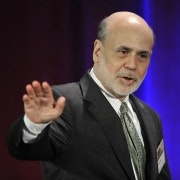Bond markets take a Fed bet too far
What is priced into the bond market in terms of its outlook for the Federal Reserve? Does the increase in interest rates sufficiently reflect the market’s perceived policy shifts?
To answer those questions, an investor must compare asset prices to fundamentals. This exercise reminds us that everything has value, but that value is ultimately determined by price.
Bond prices and yields have moved sharply of late, and many investors are concerned that rates will continue to rise. Pimco believes that while technical influences related to the bond sell-off could lead to further volatility in the short run, rates won’t ultimately move too far from current levels.
Our conviction is strengthened by an examination of what the markets are priced for. Here, the story is compelling, because the bond market is now priced for significant interest rate hikes. This is a big shift in sentiment from only a few months ago. In fact, the increases should actually limit a further rise in market rates – because rate hikes are already priced in!
Rate hikes have likewise been priced into eurodollar and federal funds futures, which reflect expectations on the outlook for the Fed’s policy rate – the federal funds rate. Both contracts are currently trading at levels that indicate a big switcheroo in outlook.
The December 2015 eurodollar contract, for example, is currently trading at around 1.6 per cent, a substantial increase compared to May, when it was at 71 basis points. Three-month Libor is currently trading close to the Federal Reserve’s 0.25 per cent target, so rates higher than that reflect expectations for Fed rate hike, plus a small yield premium to account for the fact that Libor tends to increase somewhat faster than the federal funds rate. This means the December 2015 contract is priced for the federal funds rate to increase a full percentage point to about 1.25 per cent. The federal funds futures market is priced for the same. To us, this scenario looks very unlikely. We also believe that the market’s timing of the first rate hike, priced for the end of 2014, is premature.
Further evidence of the shift in outlook can be found in data from the Commodity Futures Trading Commission, indicating that noncommercial traders in eurodollar contracts have switched their collective position from long to short since May, meaning that they are betting on rate increases. In May, these traders, generally viewed as speculators, were collectively long about 670,000 contracts; a year ago they were long about 1 million. Today? As of August 13, they’re short about 150,000 contracts. Similar switcheroos from long to short have occurred in 10-year Treasury note contracts.
Pimco shares the view with the Fed that the timing implied by current pricing is difficult to rationalise. The Fed has provided investors with clear guidance on the federal funds rate, as presented in its June 19 policy statement:
“The Committee decided to keep the target range for the federal funds rate at 0 to 0.25 per cent and currently anticipates that this exceptionally low range for the federal funds rate will be appropriate at least as long as the unemployment rate remains above 6.5 per cent, inflation between one and two years ahead is projected to be no more than a half percentage point above the Committee's 2 per cent longer-run goal, and longer-term inflation expectations continue to be well anchored” (Facing up to the Fed's moment of truth, August 22)
So how soon will the 6.5 per cent unemployment threshold be reached? With the jobless rate falling about a half percentage point per year and a current rate of 7.4 per cent, probably in about two years. To reach 6.5 per cent unemployment by the end of 2014, as the market has priced, would require monthly payroll gains of about 300,000 per month – a gigantic leap of more than 100,000 per month compared to the past year, and something that has occurred only ten times in ten years.
Furthermore, the Fed is likely to be patient when the jobless rate reaches its target, owing to inflation that’s at a 50-year low, based on the Fed’s favoured inflation gauge. This could add another six to nine months to the timeline, meaning the first rate hike may not occur until 2016. Yet, the markets are already priced for four quarter-point hikes by the end of 2015. To price in still more would be excessive to say the least.
The switch in positioning suggests markets are now far more prepared for the possibility of a rise in market interest rates than they were before. In particular, the pricing in of Fed rate hikes provides a significant cushion against further increases in market interest rates. There’s only so far a market can move on the same thing, whether it is earnings data, economic indicators or Fed policy.
Tony Crescenzi is executive vice-president at Pimco. © Pacific Investment Management Company LLC. Republished with permission. All rights reserved.
















